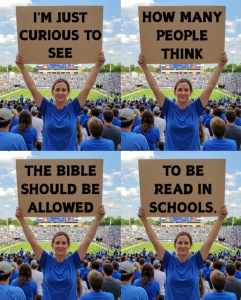Historical Context of Religious Texts in Public Schools
The role of the Bible in American public schools has evolved significantly since the nation’s founding. In the early 19th century, Bible reading was commonplace in many schools, reflecting the predominantly Protestant Christian character of the population. The King James Bible was often used as both a religious text and a reading primer. However, as the nation became more religiously diverse through immigration (particularly of Catholics, Jews, and later followers of other world religions), objections to mandatory Bible reading grew.
The landmark 1963 Supreme Court case Abington School District v. Schempp fundamentally changed this landscape. The Court ruled that mandatory Bible readings and recitation of the Lord’s Prayer in public schools violated the Establishment Clause of the First Amendment. This decision didn’t ban the Bible from schools entirely but established that schools couldn’t endorse or require particular religious practices.
Legal Framework: What’s Currently Allowed
Under current U.S. law:
-
The Bible cannot be used for devotional purposes or religious instruction in public schools
-
The Bible can be studied as literature, as part of comparative religion courses, or in historical contexts
-
Individual students can bring and read Bibles during free reading time
-
Student-led Bible study groups can meet on school grounds under the same conditions as other extracurricular groups
This framework attempts to balance the Free Exercise Clause (protecting individual religious expression) with the Establishment Clause (preventing government endorsement of religion). Similar balances exist in other Western democracies, though the specifics vary by country.
The Case for Allowing Bible Study in Schools
Proponents argue for including the Bible in schools for several reasons:
1. Literary and Cultural Significance
The Bible has profoundly influenced Western literature, art, music, and philosophy. From Shakespeare to Michelangelo to Martin Luther King Jr.’s speeches, biblical references abound. Understanding these allusions enriches students’ comprehension of cultural heritage. About 60% of literary allusions in a survey of Western literature were found to be biblical in origin.
2. Historical Importance
Biblical narratives and teachings have shaped laws, ethical systems, and historical events. The Ten Commandments influenced legal codes, while biblical concepts of human dignity underpin many human rights frameworks. Studying these influences helps students understand societal foundations.
3. Comparative Religion Education
In our globalized world, religious literacy is increasingly important. Studying the Bible alongside other sacred texts can promote understanding in our pluralistic society. A 2019 Pew study found that only 43% of Americans could correctly identify what the Bible says about Jonah, suggesting significant gaps in basic religious knowledge.
4. Moral and Ethical Development
Many argue the Bible offers valuable moral teachings about compassion, justice, and personal responsibility that could benefit character education programs. The Golden Rule (“Do unto others…”) appears in some form in nearly every major religion.
5. Academic Freedom
Some educators maintain that excluding the Bible entirely amounts to censorship of an important historical document, while including it (in an academic context) respects intellectual openness.
Concerns and Counterarguments
Opponents raise several valid concerns:
1. Church-State Separation Issues
Many fear any Bible use in schools could violate constitutional principles, especially if not handled carefully. Even academic study could devolve into implicit endorsement in some communities.
2. Diversity and Inclusion Challenges
With increasing religious diversity (about 26% of Americans now identify as religiously unaffiliated, per Pew), favoring one text might make minority students feel excluded. There are also different Christian Bibles (Protestant, Catholic, Orthodox) with varying books.
3. Interpretation Disputes
The Bible contains passages about slavery, gender roles, and violence that have been interpreted in conflicting ways throughout history. Teachers may struggle to present these objectively.
4. Age-Appropriateness Questions
Some biblical narratives contain mature content (genocide, rape, etc.) that parents might consider inappropriate for certain age groups.
5. Implementation Practicalities
Would classes focus on the Hebrew Bible/Old Testament? New Testament? Both? How much class time is appropriate? Who would train teachers to handle this material objectively?
International Perspectives
Examining how other nations handle this issue provides valuable insights:
-
United Kingdom: State-funded schools must provide daily collective worship of “broadly Christian character,” though parents can opt out. Religious education covering multiple faiths is mandatory.
-
Germany: Religion classes (divided by denomination) are standard, with ethics alternatives. The Bible is studied within this framework.
-
France: Public schools maintain strict secularism (laïcité), excluding religious texts from curriculum except in historical/literary contexts.
-
India: Schools avoid favoring any religion in this highly diverse nation, though some states have faced controversy over Hindu nationalist influences.
These models demonstrate that reasonable societies can adopt different approaches balancing cultural heritage with pluralism.
Potential Middle Ground Solutions
Several approaches might respect both the Bible’s importance and constitutional principles:
1. Literature Courses
Studying the Bible as foundational literature, similar to Greek myths or Shakespeare. Many secular universities already offer such courses.
2. Comparative Religion Classes
Placing the Bible alongside the Quran, Bhagavad Gita, and other texts in a neutral, academic study of world religions.
3. Elective Options
Offering Bible-related courses as electives rather than requirements, allowing interested students to choose participation.
4. Extracurricular Clubs
Supporting student-led Bible study groups that meet outside class time, open to voluntary participation.
5. Teacher Training Programs
Developing rigorous standards and training for educators who teach religious texts to ensure academic rather than devotional approaches.
Personal Reflection and Conclusion
Having examined these perspectives, I believe the Bible can appropriately be included in public schools when handled with academic rigor and respect for pluralism. Complete exclusion seems an overreaction to its undeniable cultural and historical significance, while devotional use clearly crosses constitutional lines. The wisest path lies in balanced, objective study that acknowledges the Bible’s influence while giving equal regard to other traditions and secular viewpoints.
In our increasingly interconnected world, religious literacy—including understanding the Bible—is an important component of global citizenship. However, this must be accomplished without privileging any faith tradition or compromising the inclusive environment public schools should maintain. With careful implementation, thoughtful curriculum design, and proper teacher training, schools can honor both our cultural heritage and our constitutional values.
Ultimately, the question isn’t just about “allowing” the Bible in schools, but about how we educate young people to thoughtfully engage with diverse ideas—religious and secular—that have shaped our world. That broader educational mission is what truly deserves our focus and careful consideration.

